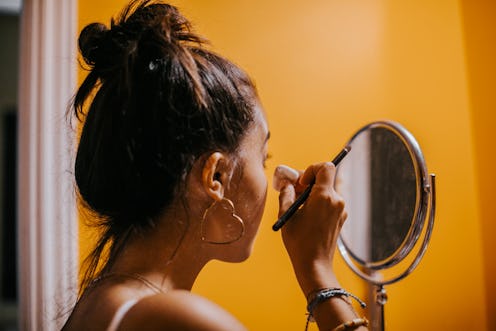Beauty
The Pros & Cons Of Using Foundation Brushes & Sponges
Different tools deliver different results.

When it comes to applying foundation, there’s no real right or wrong way to do it. Some prefer their hands while, others swear by beautyblenders. Some people aren’t sure if the application method even makes a difference at all. (Spoiler alert: it does — but there will be more on that later.)
At the end of the day, it truly all comes down to personal preference and the kind of look you’re going for. Two popular ways to put on foundation — with a brush or a sponge — requires some thought before you reach for either one. If you’re not sure whether to use a foundation brush vs. a sponge, prepare to take notes.
In order to get the scoop on the best foundation tools, Daniel Martin, celebrity makeup artist, and Neil Scibelli, celebrity makeup artist and key makeup artist at the New York City Ballet, break down the main differences between applying foundation with a brush and sponge. Read on below to see which best meets your complexion makeup needs. And if you need suggestions for the best brushes and sponges for foundation, there are thorough recommendations from both pros.
The Best Time To Use A Foundation Brush
According to Martin, a foundation brush allows you to use less product. Plus, you can spread it easily on skin to get the desired amount of coverage. Foundation brushes can be used on any skin type, with some being better suited for some than others. For those with sensitive skin, Martin suggests looking for a buffing foundation brush as those will be less irritating on the skin.
Brushes typically work with any foundation formula, whether it be liquid, cream, or powder. Martin says it depends on your skill level and how much coverage you want to achieve. “Understand your method of application and shop accordingly,” he says. “If you like to buff on foundation, find a brush head that is more round. If you like to ‘paint’ on your foundation, find a brush that is flatter and looks like a paintbrush.” He likes a tool like the Rephr Foundation Brush #31 because it works with any skin type and it is easy to get into narrow spaces for better distribution.
When you apply your foundation, use quick strokes or a patting motion. Scibelli explains that this will build the product onto the skin and prevent it from streaking. If you’re working with liquid foundation, he says to use the back of your hand or a flat steel palette as a place to pick up product from.
The Best Time To Use A Foundation Sponge
Foundation sponges are pretty versatile, too. They work well with creams, liquids, and even pressed powder. If you’re a brush devotee and unsure how to apply foundation with a sponge, the usage depends on the type of coverage and finish you want.
Scibelli explains that a makeup sponge can absorb more product than a brush, giving a more “diffused look” to your foundation. Martin, on the other hand, doesn’t use a sponge by itself (“It absorbs too much of the foundation and it can look cakey heave once applied,” he explains) and instead likes to use a sponge along with a brush to really meld and diffuse the foundation on the skin. He adds that sponges have the ability to bounce all over the face, allowing you to build up to a full-coverage finish.
“This is purely preference depending on the type of coverage you want from your complexion products,” says Martin. He likes to use a damp sponge with a powder (his pick is the Charlottle Tilbury Powder) for touch-ups, as it cancels out excess shine without making you look too flat and matte.
Sponges come in different shapes, and Scibelli says to take advantage of the different angles to blend foundation in those hard-to-reach areas. He finds a “dabbing” method is the most effective when putting on foundation.
Most importantly, remember to clean your sponge. “Please wash your sponge after every use,” says Martin. “Sponges carry much more bacteria than brushes because [the bacteria gets] deeper into the sponge and can build up if not washed properly.” Bacteria equals breakouts, so make sure that any makeup application tool that touches your face is clean.